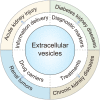Emerging role of extracellular vesicles in kidney diseases
- PMID: 36172178
- PMCID: PMC9510773
- DOI: 10.3389/fphar.2022.985030
Emerging role of extracellular vesicles in kidney diseases
Abstract
Many types of renal disease eventually progress to end-stage renal disease, which can only be maintained by renal replacement therapy. Therefore, kidney diseases now contribute significantly to the health care burden in many countries. Many new advances and strategies have been found in the research involving kidney diseases; however, there is still no efficient treatment. Extracellular vesicles (EVs) are cell-derived membrane structures, which contains proteins, lipids, and nucleic acids. After internalization by downstream cells, these components can still maintain functional activity and regulate the phenotype of downstream cells. EVs drive the information exchange between cells and tissues. Majority of the cells can produce EVs; however, its production, contents, and transportation may be affected by various factors. EVs have been proved to play an important role in the occurrence, development, and treatment of renal diseases. However, the mechanism and potential applications of EVs in kidney diseases remain unclear. This review summarizes the latest research of EVs in renal diseases, and provides new therapeutic targets and strategies for renal diseases.
Keywords: chronic kidney disease; exosomes; extracellular vesicles; kidney diseases; urinary extracellular vesicles.
Copyright © 2022 Xiang, Zhang and Xiong.
Conflict of interest statement
The authors declare that the research was conducted in the absence of any commercial or financial relationships that could be construed as a potential conflict of interest.
Figures


Similar articles
-
Extracellular vesicles in diagnosis and therapy of kidney diseases.Am J Physiol Renal Physiol. 2016 Nov 1;311(5):F844-F851. doi: 10.1152/ajprenal.00429.2016. Epub 2016 Aug 31. Am J Physiol Renal Physiol. 2016. PMID: 27582107 Free PMC article. Review.
-
Application potential of stem/progenitor cell-derived extracellular vesicles in renal diseases.Stem Cell Res Ther. 2019 Jan 8;10(1):8. doi: 10.1186/s13287-018-1097-5. Stem Cell Res Ther. 2019. PMID: 30616603 Free PMC article. Review.
-
Extracellular vesicles in kidneys and their clinical potential in renal diseases.Kidney Res Clin Pract. 2021 Jun;40(2):194-207. doi: 10.23876/j.krcp.20.209. Epub 2021 Apr 13. Kidney Res Clin Pract. 2021. PMID: 33866768 Free PMC article.
-
Extracellular Vesicles and Their Role in Urologic Malignancies.Eur Urol. 2016 Aug;70(2):323-31. doi: 10.1016/j.eururo.2016.02.046. Epub 2016 Feb 28. Eur Urol. 2016. PMID: 26924769 Review.
-
Hypoxic mesenchymal stem cell-derived extracellular vesicles ameliorate renal fibrosis after ischemia-reperfusion injure by restoring CPT1A mediated fatty acid oxidation.Stem Cell Res Ther. 2022 May 7;13(1):191. doi: 10.1186/s13287-022-02861-9. Stem Cell Res Ther. 2022. PMID: 35526054 Free PMC article.
Cited by
-
Still finding ways to augment the existing management of acute and chronic kidney diseases with targeted gene and cell therapies: Opportunities and hurdles.Front Med (Lausanne). 2023 Mar 7;10:1143028. doi: 10.3389/fmed.2023.1143028. eCollection 2023. Front Med (Lausanne). 2023. PMID: 36960337 Free PMC article. Review.
-
A new era in the science and care of kidney diseases.Nat Rev Nephrol. 2024 Jul;20(7):460-472. doi: 10.1038/s41581-024-00828-y. Epub 2024 Apr 4. Nat Rev Nephrol. 2024. PMID: 38575770 Review.
-
Worldwide hotspots and trends in stem cell therapy for kidney disease in the last decade: a bibliometric and visualization analysis from 2015 to 2024.Front Immunol. 2025 Jul 21;16:1619291. doi: 10.3389/fimmu.2025.1619291. eCollection 2025. Front Immunol. 2025. PMID: 40761782 Free PMC article.
-
Exploring the correlation between periodontal disease and serum biomarkers in haemodialysis patients.BMC Oral Health. 2024 Sep 11;24(1):1066. doi: 10.1186/s12903-024-04826-1. BMC Oral Health. 2024. PMID: 39261859 Free PMC article.
-
Advances in Purification, Modification, and Application of Extracellular Vesicles for Novel Clinical Treatments.Membranes (Basel). 2022 Dec 8;12(12):1244. doi: 10.3390/membranes12121244. Membranes (Basel). 2022. PMID: 36557150 Free PMC article. Review.
References
Publication types
LinkOut - more resources
Full Text Sources

